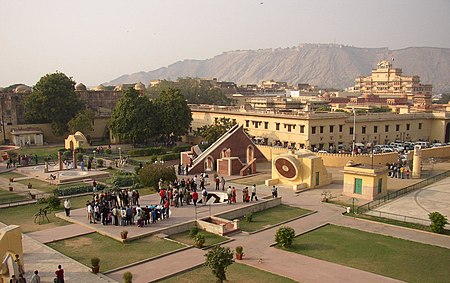Jantar Mantar

A Jantar Mantar (Hindustani pronunciation: [d͡ʒən̪t̪ər mən̪t̪ər]) is an assembly of stone-built astronomical instruments, designed to be used with the naked eye. There were five Jantar Mantars in India, all of them built at the command of the Rajah Jai Singh II, who had a keen interest in mathematics, architecture and astronomy; The largest example is the equinoctial sundial belonging to Jaipur's assembly of instruments, consisting of a gigantic triangular gnomon with the hypotenuse parallel to the Earth's axis. On either side of the gnomon is a quadrant of a circle, parallel to the plane of the equator. The instrument can be used with an accuracy of about 2 seconds by a "skilled observer" to measure the time of day, and the declination of the Sun and the other heavenly bodies. It is the world's largest stone sundial, known as the Vrihat Samrat Yantra. The Jaipur Jantar Mantar is a UNESCO World Heritage Site.
Excerpt from the Wikipedia article Jantar Mantar (License: CC BY-SA 3.0, Authors, Images).Jantar Mantar
Tripolia Bazaar, Jaipur Ramganj
Geographical coordinates (GPS) Address Nearby Places Show on map
Geographical coordinates (GPS)
| Latitude | Longitude |
|---|---|
| N 26.924444444444 ° | E 75.824861111111 ° |
Address
Sun Dial
Tripolia Bazaar
302001 Jaipur, Ramganj
Rajasthan, India
Open on Google Maps







